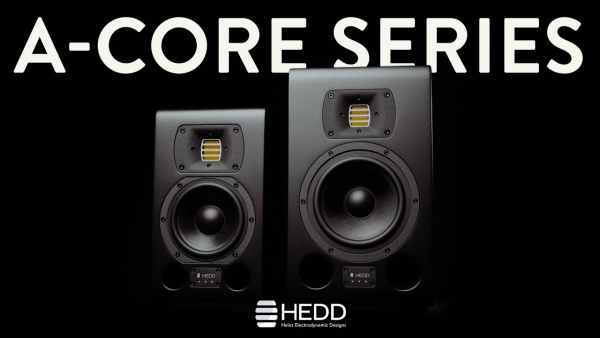HEDD Audio’s A-CORE Range of Monitors Is Its “Most Advanced Analogue Loudspeakers to Date”
In the increasingly saturated world of studio monitors, it’s rare for a new product range to genuinely excite audio professionals across the board. Yet with its recent announcement of the A-CORE series, German audio manufacturer HEDD Audio has done just that—capturing the attention of producers, engineers, and audiophiles worldwide.
HEDD calls the A-CORE monitors its “most advanced analogue loudspeakers to date,” and that’s no hollow claim. This new range marks a significant leap forward in both sonic fidelity and engineering design, drawing upon the company’s rich legacy in speaker innovation while pushing the boundaries of what modern analog monitoring can deliver.
But what exactly makes A-CORE so groundbreaking? How does it differ from HEDD’s previous offerings? And what does it mean for today’s studio environment?
Let’s dive into the details of the A-CORE range, unpacking its design philosophy, features, and why this launch could represent a paradigm shift in analogue monitoring.
A Brief Background: Who Is HEDD Audio?
Before we get technical, it’s worth exploring the pedigree behind the A-CORE line.
HEDD Audio (Heinz Electrodynamic Designs) was founded by Klaus Heinz and his son Freddy Heinz, both of whom bring deep expertise in speaker design and pro audio engineering. Klaus was the co-founder and chief engineer at ADAM Audio, where he helped popularize the Air Motion Transformer (AMT) tweeter in studio monitors—a design that still resonates with producers today.
When Klaus and Freddy launched HEDD in 2015, their goal was to combine the warmth and reliability of analogue designs with modern digital adaptability. Since then, HEDD’s Type series and HEDDphone have earned them a reputation for precision, innovation, and uncompromising sound quality.
The new A-CORE monitors continue this lineage but shift focus heavily back to pure analog excellence—no digital signal paths, no compromises.
What Is the A-CORE Range?
The A-CORE range is a new line of active studio monitors developed with a fully analog signal chain and HEDD’s most refined acoustic and amplification technologies to date.
“A-CORE” stands for Analogue CORE Technology, and the key philosophy is clear: deliver ultra-transparent, dynamic, and lifelike sound reproduction using only analog components—from input to output—without sacrificing precision or flexibility.
This isn't a throwback to vintage designs, but rather a redefinition of what modern analog monitoring can achieve.
The range includes:
-
HEDD A07 CORE – 2-way nearfield monitor (7” woofer, 1” AMT tweeter)
-
HEDD A09 CORE – Larger 2-way nearfield/compact midfield (9” woofer)
-
HEDD A11 CORE – 3-way midfield monitor (5” midrange, 1” AMT, 11” woofer)
-
HEDD BASS 12 CORE – Active subwoofer (12” woofer, high headroom, matching voicing)
Each speaker in the series has been designed to provide honest, high-resolution sound across the frequency spectrum, optimized for mixing, mastering, sound design, and critical listening.
Key Features & Innovations
1. Fully Analogue Signal Path
At the heart of the A-CORE concept is its pure analog signal chain. Unlike many modern studio monitors that rely on DSP for crossover management or frequency correction, the A-CORE monitors maintain a fully analog topology from input to amplifier to driver.
Why does this matter?
-
Zero latency: No digital conversion, no DSP-induced delay.
-
Phase integrity: Analog crossovers are meticulously tuned for natural phase response.
-
No aliasing or quantization errors: Preserving the nuances of high-resolution analog and digital sources alike.
This makes the A-CORE monitors ideal for mastering engineers and audiophiles who demand the highest fidelity and signal purity.
2. New AMT Tweeter with Refined Waveguide
HEDD has long been known for its custom Air Motion Transformer (AMT) tweeters, and the A-CORE series debuts their most advanced iteration yet.
The AMT tweeter offers:
-
Lightning-fast transient response
-
Extended high-frequency detail
-
Low distortion, even at high volumes
What’s new is the waveguide design, which has been acoustically optimized to better integrate the tweeter with the woofer or midrange driver, resulting in a smoother crossover region and improved directivity. The result is a more coherent stereo image and more accurate high-end response in real-world studio environments.
3. CORE Power Amplification
The A-CORE range introduces a new proprietary amplifier architecture: CORE Amp Technology. These are high-headroom, Class D amplifiers carefully matched to the speaker drivers, delivering:
-
Ultra-low distortion
-
Flat frequency response at all SPLs
-
Wide dynamic range
-
Tight transient response
The amplifiers are mounted inside the cabinet using a special thermal dissipation design, which prevents overheating while maintaining silent operation.
Each speaker uses separate amplifiers for each driver, ensuring full control over the sonic output and maximized headroom per driver.
4. Acoustically Optimized Cabinets
Cabinet design is just as crucial as the drivers themselves. The A-CORE enclosures are made from dense MDF with internal bracing, designed to minimize resonances and coloration.
Highlights include:
-
Custom-designed bass reflex ports for accurate low-end extension and reduced chuffing.
-
Angled baffle design to minimize edge diffraction and improve imaging.
-
Matte finish with minimal branding, suitable for professional environments and free from visual distractions.
The result is consistent off-axis response, tight bass, and clear midrange definition.
5. Front-Panel Control & Rear Trim Options
While the A-CORE range remains 100% analog, it’s far from inflexible. HEDD has added smart analog trim controls on the rear for:
-
Input sensitivity
-
Low-shelf and high-shelf EQ
-
Midrange tilt filters (on the A11 CORE)
On the front, users will find power indicators and LED clipping signals, with the ability to fine-tune each speaker to its environment without digital processing. This analog approach supports pure signal flow while giving the user control over room interaction.
Why Go Fully Analogue in a Digital World?
In an era dominated by DSP-driven monitors offering FIR filtering, Bluetooth, room correction, and mobile apps, HEDD’s all-analogue approach might seem unconventional. But there are compelling reasons behind this design philosophy.
1. Transparency Without Tampering
DSP is often used to correct inadequacies in speaker design. By focusing instead on driver integration, cabinet resonance, and analog crossover precision, HEDD delivers transparency without compromise or coloration.
2. Latency-Free Performance
For live recording, syncing with outboard gear, or simply ensuring the most natural monitoring experience, zero-latency is a game-changer—especially when compared to DSP monitors that can introduce 1–3 ms of delay.
3. Purist Signal Chain
From mixing desks to mastering gear, many engineers prefer analog chains for their warmth and precision. The A-CORE monitors honor that signal chain without inserting unnecessary AD/DA conversions.
Use Cases & Applications
1. Mastering Studios
With their linear frequency response, phase coherence, and zero latency, the A-CORE monitors are ideal for mastering applications where every micro-detail matters. The A11 CORE in particular, with its 3-way design, delivers surgical midrange accuracy.
2. High-End Mixing Rooms
The A07 and A09 provide transparent, punchy nearfield monitoring perfect for mixing engineers who demand honesty in their listening environment.
3. Post-Production & Sound Design
In film, gaming, and TV post-production, reliable imaging and time alignment are crucial. A-CORE monitors offer fast transient response, pinpoint imaging, and consistency across volumes.
4. Audiophile Listening
Though designed for studios, the A-CORE’s purity and analog ethos make them highly attractive to audiophiles seeking reference-grade loudspeakers for high-end music playback systems.
Comparing with Previous HEDD Monitors
HEDD’s Type Series (Type 05, 07, 20, 30) are already well-respected in the monitoring world, offering hybrid analog/DSP designs and digital expansion capabilities.
Compared to the Type Series:
-
A-CORE is fully analog, while Type offers optional digital cards.
-
A-CORE delivers more refined cabinet acoustics and a higher-end amplifier architecture.
-
The new AMT waveguide in A-CORE provides more focused imaging and smoother highs.
-
A-CORE is designed for pro users who demand signal path integrity above all else.
Price & Availability
As of May 2025, HEDD has begun global distribution of the A-CORE series through select dealers and professional audio retailers. Estimated prices (per speaker) are:
-
HEDD A07 CORE – $1,299 USD
-
HEDD A09 CORE – $1,799 USD
-
HEDD A11 CORE – $2,499 USD
-
HEDD BASS 12 CORE – $1,599 USD
Given their design pedigree and build quality, these monitors sit in the premium tier, aimed squarely at pros and high-end studios—not casual bedroom setups.
Final Thoughts: A Return to Precision, Not Nostalgia
With the A-CORE range, HEDD Audio has achieved something rare: a genuinely forward-thinking analog monitor that embraces the best of the past without feeling retro or restrictive. It’s a product line that challenges the assumption that DSP is the only path to sonic precision.
By focusing on mechanical engineering, crossover precision, and amplifier excellence, HEDD proves that analog monitoring still has a major role to play in the digital age—especially for professionals who know that what you hear shapes what you create.
If you’re looking for uncolored, accurate, and phase-coherent monitoring, without the influence of digital manipulation, the A-CORE series may just be the most compelling option on the market today.
Are you excited about the A-CORE range? Would you choose analog over DSP in your studio? Let us know in the comments below.
For more studio monitor reviews, gear updates, and pro audio insights, subscribe to our newsletter or follow us on our X account here.


